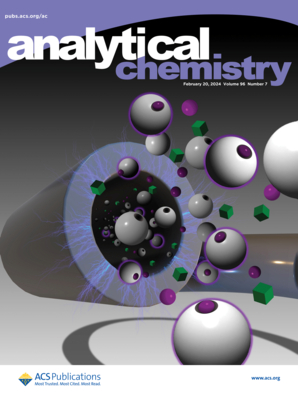Dual-Channel Catalytic Immunochromatography Empowered by Machine Learning: Ultrasensitive Detection of Escherichia coli O157:H7 via Magnetic CoFe2O4@HRP Nanocomposites.
IF 6.7
1区 化学
Q1 CHEMISTRY, ANALYTICAL
引用次数: 0
Abstract
Traditional immunochromatographic test strips face significant limitations in detecting trace levels of Escherichia coli O157:H7 due to insufficient sensitivity and reliability. To address this challenge, we developed a novel "three-In-One" nanoplatform based on magnetic CoFe2O4 NPs functionalized with horseradish peroxidase (HRP) for dual-channel lateral flow immunoassay (LFIA). The secondary catalytic channel, leveraging HRP-mediated oxidation of 3,3',5,5'-tetramethylbenzidine (TMB), enables signal amplification, achieving an unprecedented detection limit of 9 CFU/mL─a 100-fold improvement over conventional gold nanoparticle-based LFIA (930 CFU/mL) and a 10-fold enhancement compared to the noncatalyzed CoFe2O4 system (93 CFU/mL). The CoFe2O4@HRP nanocomposite demonstrates remarkable synergistic effects, combining the magnetic separation capability of CoFe2O4 with the catalytic activity of HRP. This integration not only enhances detection sensitivity but also improves the aqueous stability and antibody loading capacity. In real food sample analyses (pork and milk), the system exhibits excellent accuracy (recovery rate: 89.29-110.71%) and precision (RSD: 3.31-7.93%). To further optimize detection performance, we implemented a robust machine learning framework incorporating deep neural networks (DNN), random forest regression, and k-nearest neighbors algorithms. This predictive model achieved exceptional agreement with experimental results (R2 > 0.999), 100% classification accuracy at the order-of-magnitude level, and >95% of predictions within Bland-Altman agreement limits. This work establishes a new paradigm for foodborne pathogen detection by synergistically combining nanomaterial engineering with artificial intelligence, offering a novel paradigm in rapid, ultrasensitive, and quantitative diagnostics for food safety monitoring and clinical applications.机器学习授权的双通道催化免疫层析:通过磁性CoFe2O4@HRP纳米复合材料超灵敏检测大肠杆菌O157:H7。
由于灵敏度和可靠性不足,传统的免疫层析试纸条在检测痕量大肠杆菌O157:H7水平方面存在显着局限性。为了解决这一挑战,我们开发了一种新型的“三合一”纳米平台,该平台基于具有辣根过氧化物酶(HRP)功能化的磁性CoFe2O4 NPs,用于双通道横向流动免疫测定(LFIA)。二级催化通道利用酶标介导的3,3',5,5'-四甲基联苯胺(TMB)氧化,实现了信号放大,达到了前所未有的9 CFU/mL的检测限──比传统的金纳米颗粒LFIA (930 CFU/mL)提高了100倍,比非催化的CoFe2O4系统(93 CFU/mL)提高了10倍。CoFe2O4@HRP纳米复合材料结合了CoFe2O4的磁分离能力和HRP的催化活性,表现出显著的协同效应。这种集成不仅提高了检测灵敏度,而且提高了水稳定性和抗体负载能力。在实际食品样品(猪肉和牛奶)分析中,该系统具有良好的准确度(回收率:89.29-110.71%)和精密度(RSD: 3.31-7.93%)。为了进一步优化检测性能,我们实现了一个鲁棒的机器学习框架,该框架结合了深度神经网络(DNN)、随机森林回归和k近邻算法。该预测模型与实验结果非常吻合(R2 > 0.999),在数量级水平上的分类准确率为100%,在Bland-Altman协议范围内的预测准确率为>95%。本研究通过纳米材料工程与人工智能的协同结合,建立了食源性病原体检测的新范式,为食品安全监测和临床应用提供了快速、超灵敏和定量诊断的新范式。
本文章由计算机程序翻译,如有差异,请以英文原文为准。
求助全文
约1分钟内获得全文
求助全文
来源期刊

Analytical Chemistry
化学-分析化学
CiteScore
12.10
自引率
12.20%
发文量
1949
审稿时长
1.4 months
期刊介绍:
Analytical Chemistry, a peer-reviewed research journal, focuses on disseminating new and original knowledge across all branches of analytical chemistry. Fundamental articles may explore general principles of chemical measurement science and need not directly address existing or potential analytical methodology. They can be entirely theoretical or report experimental results. Contributions may cover various phases of analytical operations, including sampling, bioanalysis, electrochemistry, mass spectrometry, microscale and nanoscale systems, environmental analysis, separations, spectroscopy, chemical reactions and selectivity, instrumentation, imaging, surface analysis, and data processing. Papers discussing known analytical methods should present a significant, original application of the method, a notable improvement, or results on an important analyte.
 求助内容:
求助内容: 应助结果提醒方式:
应助结果提醒方式:


